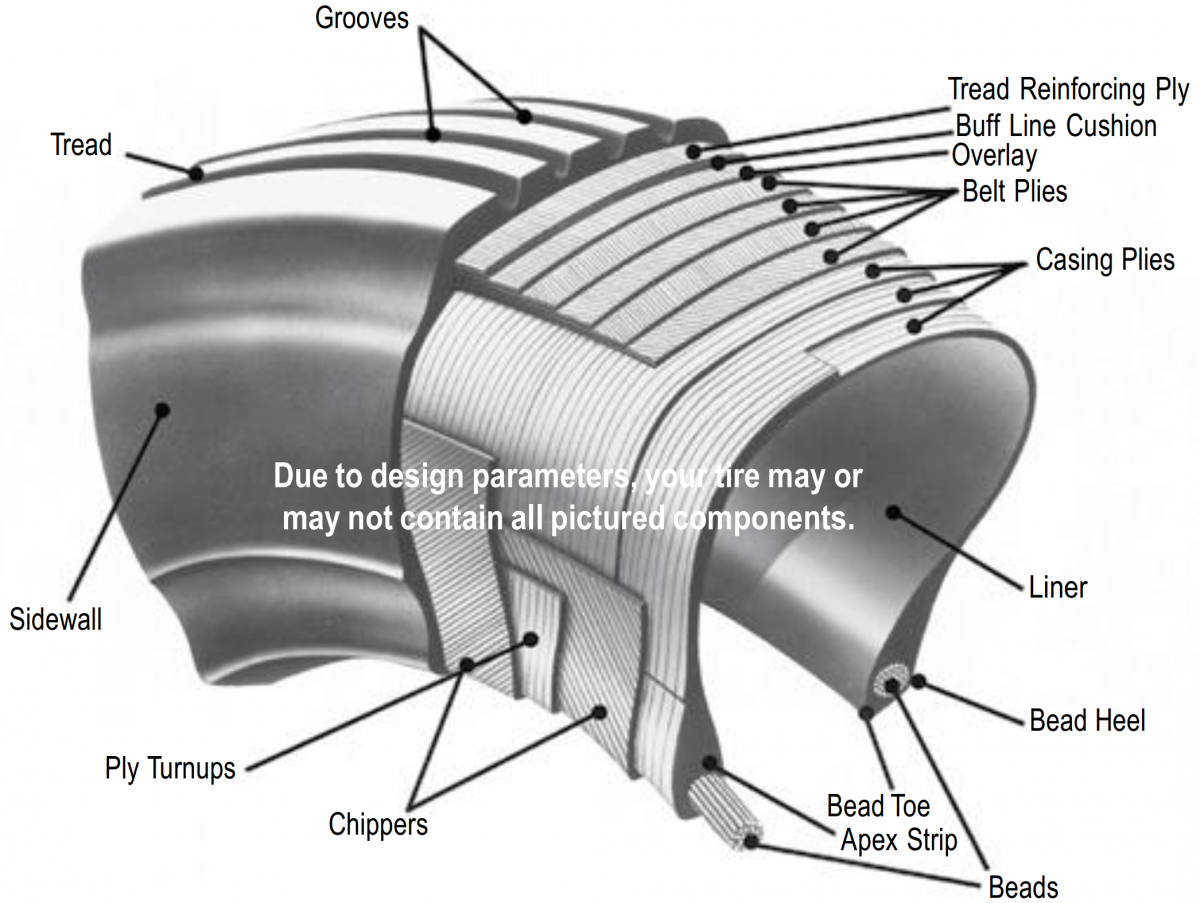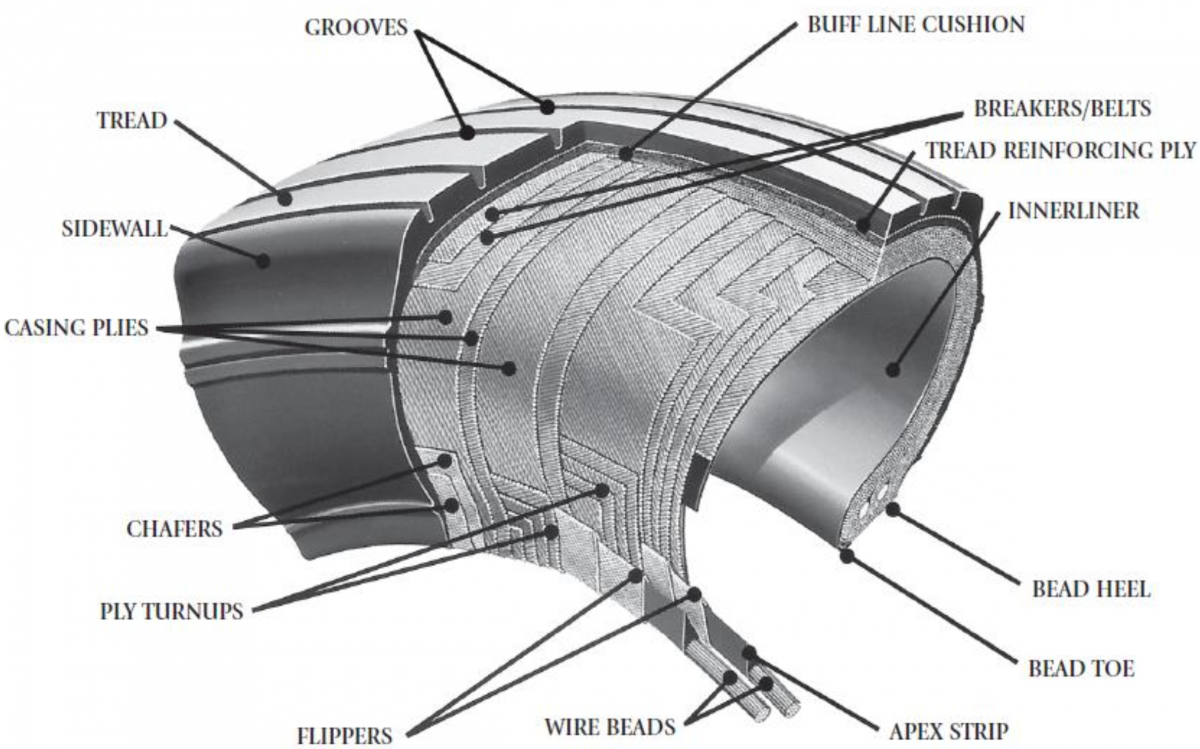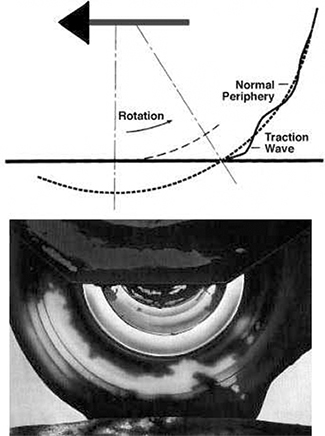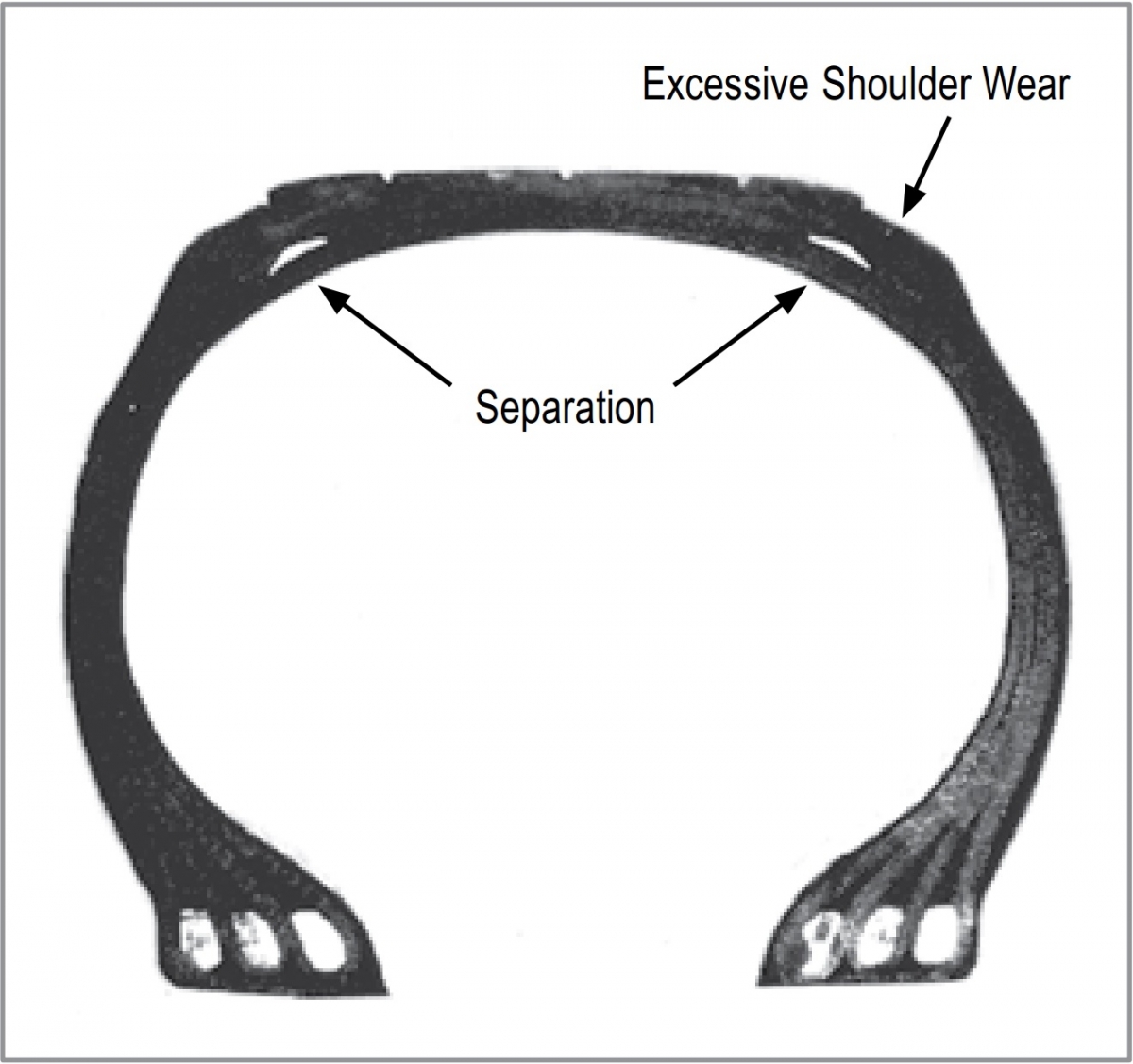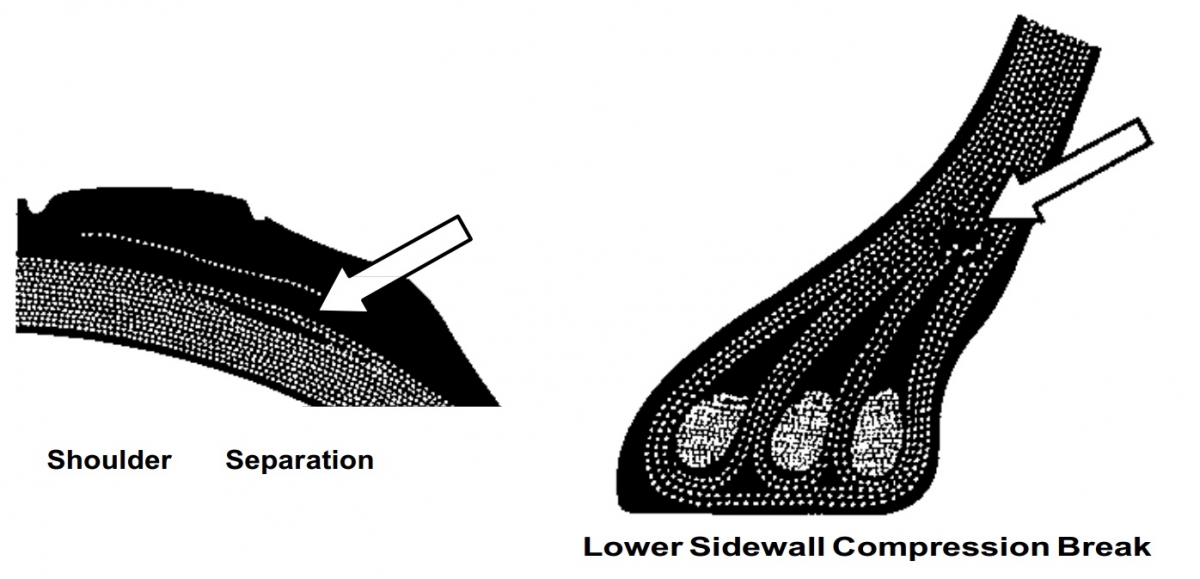Introduction
This article gives an overview of the tyre types used in aircraft and describes best practices for tyre handling and maintenance.
The recommendations given do not supersede local storage facility regulations, ground transportation restrictions, or prevailing aviation authority requirements. Depending on local regulations, it may be the operator’s responsibility or the tyre handler (shipping or storage)’s responsibility to ensure compliance with the requirements.
Tyre Types
Based on the type of plies used the tyres can be:
- Radial ply tires - these tyres feature a flexible casing which is constructed of rubber-coated ply cords which extend around the beads and are substantially at 90° to the centerline of the tread. The casing is stabilized by an essentially inextensible circumferential belt.
Composition of a radial ply tyre
- Bias ply tires - these tyres feature a casing which is constructed of alternate layers of rubber-coated ply cords which extend around the beads and are at alternate angles substantially less than 90° to the center line of the tread.
Composition of a bias ply tyre
Based on the method for containing the inflation gas the tyres can be:
- Tube-type tyres - these require tubes for inflation retention.
- Tubeless tyres - these do not require tubes. They are constructed with an innerliner (integral rubber lining that is engineered to prevent the diffusion of the inflation gas into the casing.).
Tyre Handling
Storage
- Tyres and tubes should be stored in a cool, dry place out of direct sunlight.
- Temperatures should be between 0°C and 30°C.
- Particular care should be taken to store tires away from fluorescent lights, electric motors, battery chargers, electric welding equipment, electric generators and similar equipment. These items create ozone, which has a deteriorating effect on rubber.
- Local aviation authority regulations may address limits to tyre and tube storage humidity limits.
- Care should be taken that tires do not come in contact with oil, gasoline, jet fuel, hydraulic fluids or similar hydrocarbons. Rubber is attacked by these in varying degrees.
- All tires and tubes should be inspected immediately upon receipt for shipping and handling damage.
- Whenever possible, tires should be stored vertically on tyre racks. The surface of the tyre rack against which the weight of the tyre rests should be flat and wide to minimize distortion.
- Stacking of most tires is permissible; however, care must be used to prevent distortion of the tires on the bottom of the stack. Manufacturer's guidance on the subject should be followed.
- Tubes should be stored in their original cartons whenever possible. If stored without their cartons, they should be lightly lubricated with talc powder and wrapped in heavy paper.
- Tubes can also be stored in matching tires. Tires should be clean and lightly lubricated with talc with tubes inflated just enough to round them out.
- Under no circumstances should tubes be hung over nails, pegs or any object that might form a crease in the tube. Such a crease will eventually produce a crack in the rubber.
- Age is generally not an indicator of tyre serviceability as long as all service criteria, visual criteria, or individual customer-imposed restrictions are met.
- It is recommended that tubes not be reused; they can grow as much as 25% in service. Reusing them can result in folded, pinched tubes which can fail or create an imbalance.
- Tyres can be inflated at operational pressure if allowed by the aviation authorities. The assemblies can be stored like this for up to 12 months. After that time, inflated assemblies that have not been used should be re-inspected to tyre appearance criteria. These reinspections can be performed multiple times as long as the tyre meets all inspection and inflation criteria.
- If the tyre does not meet the inspection and inflation criteria, the tyre should either be scrapped or returned for retreading, depending on the tire’s condition. For assemblies stored for extended periods of time, inflation pressure retention checks should be performed to help re-verify the airworthiness of the assembly.
Mounting
- Correct mounting and demounting of aircraft tyres and tubes are essential for maximum safety and economy. It is a specialized job that should be done only by fully trained persons with the proper tools and with careful attention to specific instructions and established procedures.
- An inflated tyre/wheel assembly is potentially explosive. Mounting and demounting of aircraft tyres is a specialized job that is best done with the correct equipment and properly trained personnel and with careful attention to specific instructions and established procedures.
- Aircraft tyres are designed to be operated up to or at rated inflation pressure. Exceeding these pressures may cause the aircraft wheel or tyre to explode, which can result in serious or fatal injury.
- Pressure regulators should always be used to help prevent injury or death caused by overpressurization of the tyre assembly. Maintenance and use of pressure regulators should be performed in accordance with the manufacturer’s instructions. The safety practices for mounting and demounting aircraft tyres referenced in the aircraft and wheel manufacturer’s maintenance manuals should be followed.
- Newly assembled tyres and wheels should be inflated in safety cages using dry nitrogen.
- Specific instructions on modern wheels are contained in maintenance manuals available from the aircraft manufacturer or directly from the wheel manufacturer. Aircraft tyres should not be mounted or dismounted without the specific information contained in these manuals.
- Tyres should be inflated to rated pressure. After a 12-hour stretch period they should be reinflated to rated pressure.
- Before placing assembly into service, 24 hour pressure-retention check should be performed to ensure that the assembly is holding pressure properly.
Dismounting
Two types of demounting equipment are mostly used: “full-circle” and partial-circle bead breakers. With both types of bead breakers, the desired procedures are a combination of pressing against the tyre sidewalls close to the edge of the wheel flanges and controlling the lateral movement of the bead breaker rings after contacting the tyre sidewalls. This procedure assures the maximum lateral force against the tyre to demount it without internal tyre damage or kinking the tyre beads.
- A tyre/wheel assembly that has been damaged in service should be allowed to cool for a minimum of three (3) hours before the tyre is deflated. The internal temperature and pressure are unknown. Extremely high temperatures reduce the strength of the plies which could result in an explosion causing serious or fatal injury.
- Prior to demounting the tyre from the wheel, it should be completely deflated with a deflation cap.
- After all the pressure has been relieved, remove the valve core. Remember that valve cores still under pressure can be ejected like a bullet. If wheel or tyre damage is suspected, approach the tyre from the front or rear, not from the side (facing the wheel).
- Leave the wheel tyre bolts tight until after unseating the tyre beads. If the bolts are loosened or removed before unseating the tyre beads, the wheel mating surfaces may be damaged.
- Radial tyres should be dismounted with full circle bead breaking equipment. Bias tyres can be dismounted with full circle bead breaking equipment.
Tyre Maintenance
Preventive Maintenance
- Check inflation pressure daily or before first flight when tyres are cool. Tyre pressures should always be checked with the tyre at ambient temperatures as they can rise in excess of 93°C above ambient during operation. A temperature change of 3°C produces approximately 1% pressure change. It can take up to 3 hours or more after a flight for tyre temperatures to return to ambient. A tyre/wheel assembly can lose as much as five percent (5%) of the inflation pressure in a 24-hour period and still be considered normal. Tyre pressures change on a daily basis.
- When tyres are going to be subjected to ambient temperature differences between two locations in excess of 27°C, inflation pressures should be adjusted to the colder temperature prior to takeoff. This also applies when checking pressure in a heated hangar in the winter.
- Nitrogen should be used for tyre inflation as it will not sustain combustion and will reduce degradation of the liner material, casing plies and wheel due to oxidation. Appropriate regulatory agency requirements for nitrogen inflation should be followed.
- It must be determined if “loaded” or “unloaded” pressure has been specified by the aircraft manufacturer. When a tyre is under load, the gas chamber volume is reduced due to tyre deflection. Therefore, if unloaded pressure has been specified, that number should be increased by 4% to obtain the equivalent loaded inflation pressure. The opposite is true as well: if loaded pressure has been specified, that number should be reduced by 4% if the tyre is being inflated while unloaded.
- Excess inflation pressure should never be bled off from hot tyres. All adjustments to inflation pressure should be performed on tyres cooled to ambient temperature.
- To prevent one tyre on a gear from carrying extra load, all tyres on a single gear should be inflated equally. The mate tyre(s) will share the load, allowing individual tyres to run underinflated or overloaded if pressures are unequal, because all tyres on the gear will deflect identically.
- Inaccurate gauges are a major source of improper inflation pressures. Gauges should be checked periodically and recalibrated as necessary.
- Tyres that have been subjected to unusually high service braking or operating conditions such as high energy rejected takeoffs or high energy overspeed landings should be removed and scrapped. Even though visual inspection may show no apparent damage, tyres may have sustained internal structural damage.
- Tyres that have deflated due to a fuse plug release should be removed and scrapped. If this has occurred in dynamic (rolling) conditions, the mate tyres have been subjected to high stress conditions and should also be removed. If this has occurred in a static (not rolling) condition, the mate tyre does not have to be removed unless it fails to pass relevant manufacturer's service or inspection criteria.
Inspecting Mounted Tyres
Systematic inspection of mounted tyres is strongly recommended for safety and tyre economy. The frequency of the inspection should be determined by the use and normal tyre wear of the particular aircraft involved. With some aircraft, tyre inspection after every landing or at every turnaround is required. With all aircraft, a thorough inspection is advisable after a hard landing.
- Treadwear - inspect treads visually and check remaining tread. tyres should be removed when tread has worn to the base of any groove at any spot, or up to 1/8 of the tyre circumference.
- Uneven Wear - if tread wear is excessive on one side, the tyre can be demounted and turned around, provided there is no exposed fabric. Gear misalignment causing this condition should be corrected.
- Tread Cuts - inspect tread for cuts and other foreign object damage and mark with crayon or chalk. Manufacturer's removal criteria should be followed.
- Sidewall Damage - remove tyre from service if weatherchecking, cracking, cuts and snags extend down to the casing ply in the sidewall and bead areas.
- Bulges - in any part of tyre tread, sidewall or bead area these may indicate a separation or damaged tyre. Mark with crayon and remove from service immediately.
- Fabric Fraying/Groove Cracking - tyres should be removed from service if groove cracking exposes fabric or if cracking undercuts tread ribs.
- Flat Spots - tyres generally need not be removed because of flat spots due to touchdown and braking or hydroplaning skids unless fabric is exposed. If objectionable vibration results, however, the assembly should be rebalanced or the tyre should be removed from service.
- Casing Flat Spotting - loaded tyres that are left stationary for any length of time can develop temporary flat spots. The degree of this flat spotting depends upon the load, tyre deflection and temperature. Flat spotting is more severe and more difficult to work out during cold weather. Under normal conditions, a flat spot will disappear by the end of the taxi run.
- Radial Tyre Sidewall Indentation - if sidewall indentation is 3mm deep or greater the tyre should be removed from service.
- Beads - bead areas next to wheel flanges should be inspected for damage due to excessive heat, especially if brake drag or severe braking has been reported during taxi, take-off or landing. If damaged, the tyre should be removed from service.
- Tyre Clearance - tyres, gear, and in wheel wells should be examined for marks that might indicate rubbing due to inadequate clearance.
- Wheels - wheels should be checked for damage. Wheels that are cracked or damaged should be taken out of service for repair or replacement in accordance with manufacturer’s instructions.
- Rim Slip - after installation, several aircraft cycles may be necessary before a tyre reaches its final position on the wheel. Tyres that move in excess of 20 degrees should be demounted and evaluated for appropriate action.
Affecting Factors
There are three major factors that affect tyre performance:
- Centrifugal force. This is a combination of load and speed. Due to centrifugal force and inertia, the tread surface doesn’t stop at its normal periphery but overshoots, briefly distorting the tyre from its natural shape. This sets up a traction wave in the tread surface. Traction wave is mostly affected by two factors - speed and underinflation. The result of traction wave exposure can be damaged tyre (e.g. groove cracking or rib undercutting).
The mechanism of traction wave and a picture of a tyre subject to traction wave
- Heat generation. Heavy loads and high speeds cause heat generation in aircraft tyres to exceed that of all other tyres. The physical properties of rubber compounds are susceptible to degradation by high temperatures. Both strength and adhesion are lost when the rubber reverts to the uncured state. Brief exposure to high temperatures is not as damaging to the tyre as are prolonged exposures. Internal heat ca cause tread and casing separations. External heat sources (e.g. brakes) can cause bead face damage.
An example of tread and casing separation
- Tensile, Compression and Shear Forces. An aircraft tyre is designed so that in the unloaded condition the internal tensile forces acting on each layer of fabric are uniform. Due to the high deflection of the tyre section under the load, the tensile forces on the outer plies will be higher than those on the inner plies. Due to the force gradient from outer to inner plies, shear forces are developed between the various layers of fabric. Underinflating or overloading a tyre will increase these shear forces, thus rapidly decreasing the life of an aircraft tyre. Common types of damage associated with these forces are shoulder separation and lower sidewall compression break.
Examples of shoulder separation and lower sidewall compression break
本站仅提供存储服务,所有内容均由用户发布,如发现有害或侵权内容,请
点击举报。


